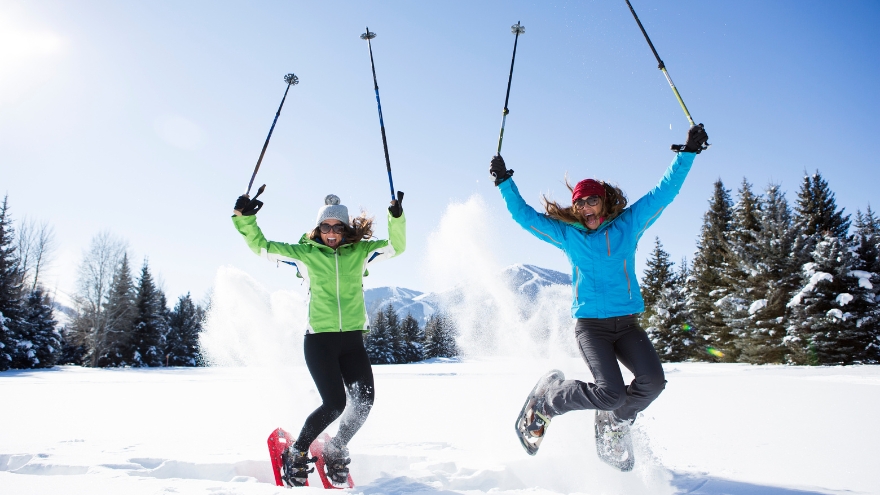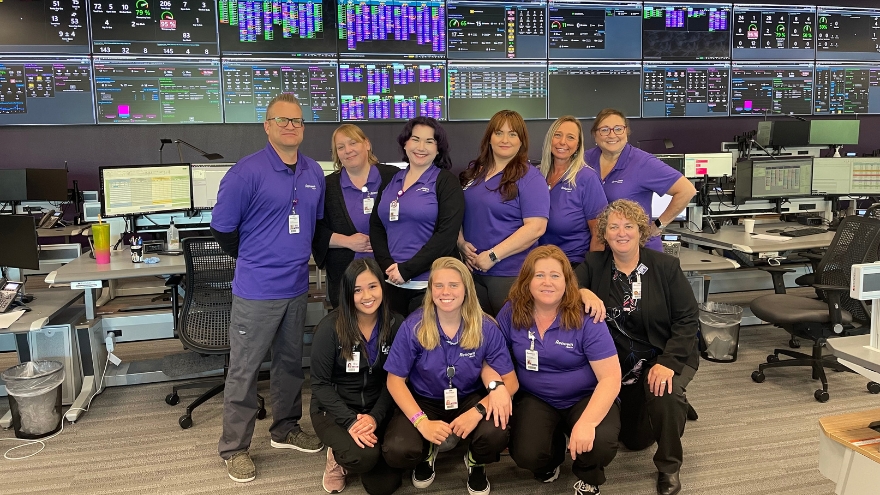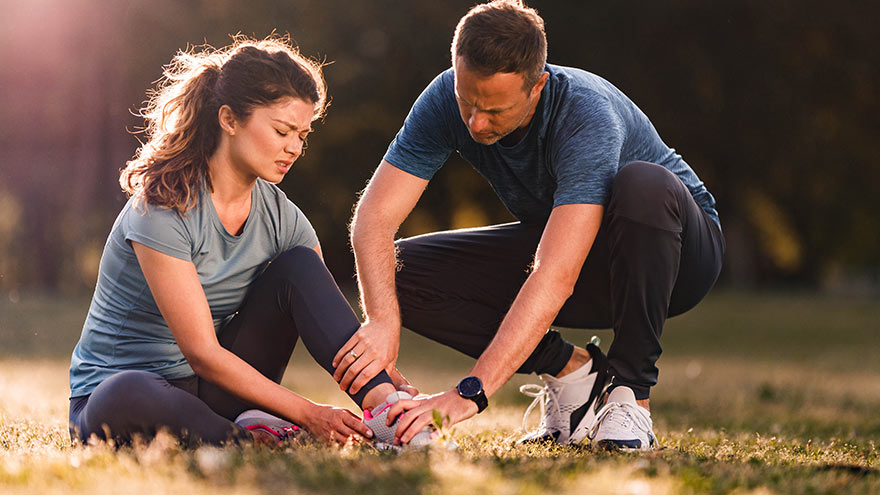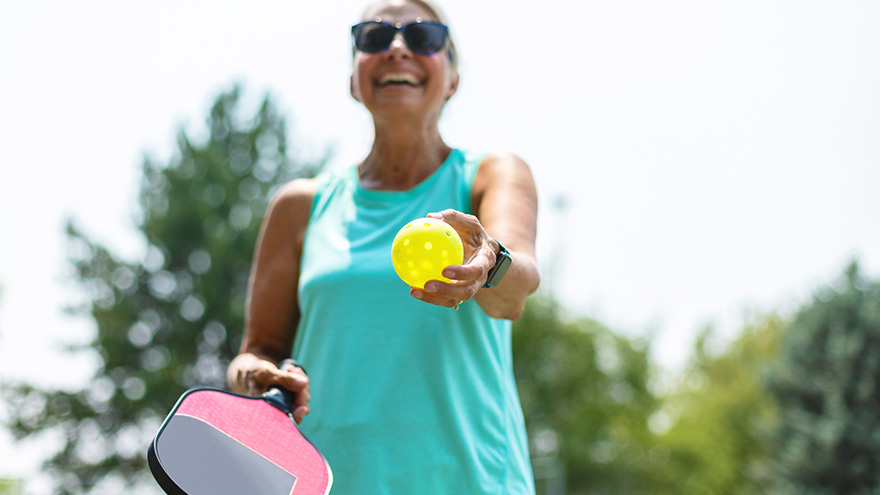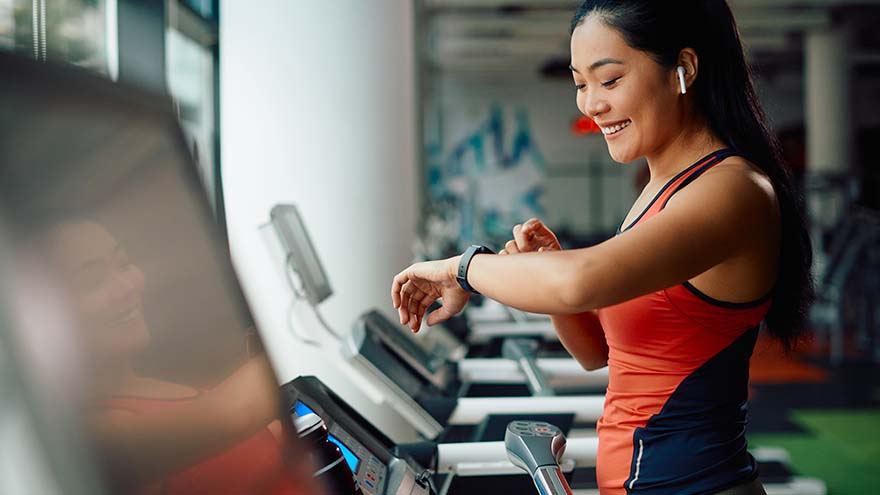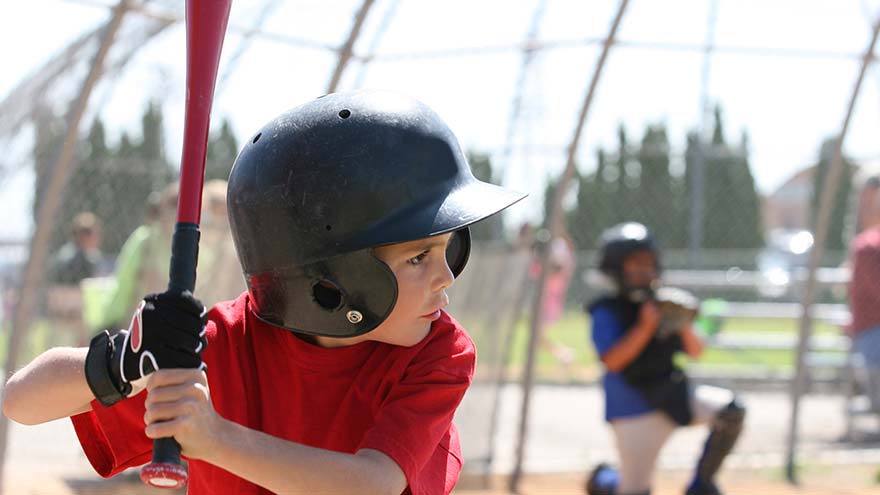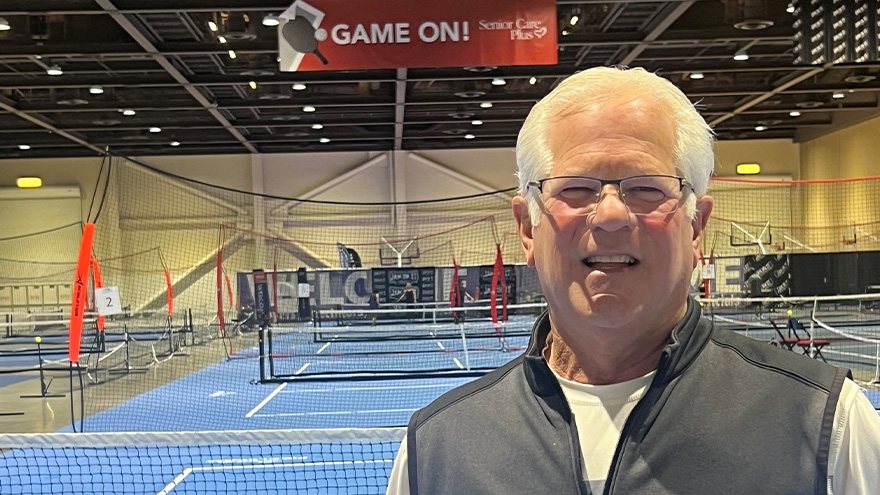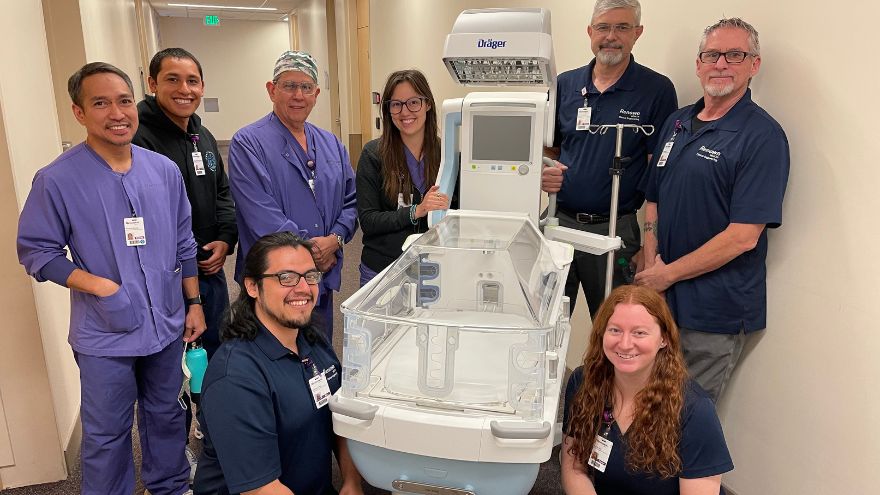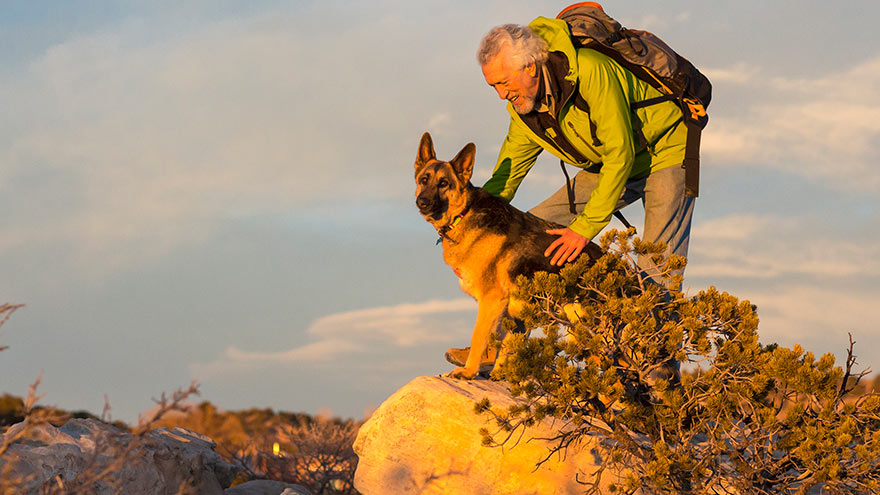Buscar
-
Asociación de Renown Health con la campaña Nevada Fitness
In 2021, Renown Health partnered with the National Fitness Campaign (NFC) to construct outdoor “Fitness Courts” in public spaces across the state. The partnership was formed to fight obesity, improve quality of life and create equitable access to outdoor exercise programs for communities around the state – bringing community wellness programs and free digital workouts to thousands of people. The Renown Health and NFC Campaign in Nevada is delivering outdoor wellness infrastructure to help communities stay active across the state and to change health outcomes. Out of Nevada's 16 counties, Fitness Courts® are now open in three. A Complete Bodyweight Workout at Seven Exercise Stations The Fitness Court is the world’s best outdoor gym that lets people use their own body weight to get a complete workout using seven exercise stations. Created for people ages 14 and over and with all abilities in mind, the workouts are adaptable for all fitness levels, allowing participants to move at their own pace. Users may also download the free Fitness Court App, which acts as a coach-in-your-pocket and enhances the outdoor gym into a digitally supported wellness experience. "Proximity to exercise opportunities, such as parks and recreation facilities, has been linked to an increase in physical activity among residents,” said Dr. Brian Erling, President & CEO of Renown Health. “Regular physical activity has a wide array of health benefits including weight control, muscle and bone strengthening, improved mental health and mood, and improved life expectancy. We are proud to bring additional access to exercise opportunities – at no charge, to everyone in our community.” Renown-Sponsored Fitness Courts Across Northern Nevada Rancho San Rafael 1595 N Sierra Street, Reno, NV 89503 South Valleys Regional Park 15650 Wedge Parkway, Reno, NV 89511 Ardmore Park 1200 12th Street, Sparks, NV 89431 Angel Park W Sage Street, Elko, NV 89801 Elquist Park 561 Altenburg Ave., Battle Mountain, NV 89820 To learn more visit Nevada Fitness Courts.
Read More About Renown Health Partnership with the Nevada Fitness Campaign
-
Departamento destacado: Datos y análisis empresariales
In the fast-paced world of healthcare, productivity is always a focus. Care teams need accurate and timely information to make decisions that directly impact our patients. However, without a reliable system to analyze and deliver complex data, noticing areas for improvement and making impactful changes can become overwhelming. This is where the power of data and analytics comes into play. Renown Health’s Enterprise Data & Analytics (EDA) department are the leaders of this transformation. This team cares for the caregiver by delivering key data and insights with thorough analytics. Their data-driven approach ensures we are moving towards consistent progress and excellence in patient care, creating a better healthcare experience for everyone. Dedicated Data Deliverers From patient volumes to quality-of-care metrics, our EDA department drives a lot of decisions that directly affect our patients and caregivers. A day-in-the-life as an EDA team member is where creativity meets science. “Data is the lifeblood of the department and my role,” said Clayton Pettit, Senior Data Analyst. “Every day, I'm working with data – figuring out how to get certain pieces of data, visualizing it to provide users with clear insights and helping users of the data glean those insights and analyze the data.” “We are builders of data tools, collaborating with team members and IT teams,” added Michelle Ebesu, Data Analyst. “We problem solve and design the most efficient way to deliver data. We work on large projects, small report requests and answer reporting related questions. We investigate and research daily.” According to this team, every day brings a blend of exploration, engagement and discovery. Their role within our health system is central to turning data into useful ideas that drive meaningful change for all. “A day on the Enterprise Data & Analytics team involves responding to diverse requests, some well-defined and others more open-ended, requiring exploratory collaboration with stakeholders,” said Kevin Crofton, Senior Data Analyst. “We harness the vast institutional knowledge within our organization to inform our analytics projects. This collaborative approach not only enhances our insights but also extends their impact across various groups within the organization.” “Each day in EDA is fast paced,” added Ryan Fernandez, Manager of Data Analytics. “Our days are filled with a variety of different tasks ranging from data wrangling, building visualization to tell a meaningful story, responding to urgent business questions with analysis, training other team members on how to use analytical tools, and constantly learning more about the different clinical service lines and how to interpret their data.” No two days are the same in EDA. In fact, every day brings a new challenge. And the best part? They’re never alone. This team thrives on working together, emulating Renown’s cultural commitment of Collaboration to a tee. “Every day is different,” said Susan McDonald, Senior Data Analyst. “On larger projects we collaborate together, with each person taking a piece. We'll meet daily to gauge progress, exchange ideas and assist each other when needed. We'll sometimes have to troubleshoot issues that may come up with some reports. We often meet with our end users to get further details on their needs or to present their requested reports.” “Up until the last couple of months, my day-to-day was creating, updating and fixing reports for all aspects of Hometown Health,” added Ryan Zinck, Data Analyst. “For the past two months we have begun the development of what will be an extensive reporting system in PowerBI that's intended to serve most groups within the company.” Working with digital healthcare information that impacts how a health system operates and makes needed improvements can be complicated, since information is entered in various ways like calculations, statistics or measurements. Susan McDonald said it best: “It’s like solving puzzles every day.” “We are Business Intelligence,” said Michele Warner, Data Analyst. “We answer questions the business proposes. We write queries and design reports/dashboards. We dig into the tables that store the data that is input by everyone at Renown through EPIC and other applications. We tell a story that will help the business be more efficient, make better decisions, solve a problem or report to government agencies.” “We dive deeper into the front-end data and analyze it to get more detailed information and insights regarding the performance and certain project,” added Boqun Yin, Data Analyst. “Then, our colleagues working at the front line can utilize it when making strategic business decisions.” EDA takes the definition of trendsetting to a whole new level. With the unique ability to predict future trends, this department can provide crucial information that helps care teams on the floor care for their patients to the best of their ability today, tomorrow and forever. “I deliver data on all sorts of topics for Renown,” said Clayton Pettit. “With this data, I help Renown see where we are and where we need to improve. Beyond that, the data I provide can help us see how we can improve, what things we need to focus on and processes we need to change.” “Our organization needs up to date robust data to ensure quality and integrity so that it’s reliable, secure and accurate,” added Uriel Duran, Data Engineer. “We also provide analytics and insights that can provide/predict patient outcomes and trends. For our patients, improving patient care is critical – and that can be done with data.” Making Your Lives Easier As stated by Brian, Howell, Manager of Data Engineering, “we’re here to make everyone’s lives easier.” And Brian is exactly right – the EDA department’s work impacts the people who care for patients. Their data analysis and engineering skills help our care teams answer questions, give them information they can make decisions with and inform them statistically about well they are doing, along with showing opportunities for growth. “EDA professionals like to think of themselves as the ‘wizard behind the curtain,’ a nuance from the ‘All Knowing’ Wizard of Oz; we are custodians of the company's data and we take that responsibility seriously,” said Dr. Justin Coran, Chief Analytics Officer. “When we partner with our clinical or administrative counterparts, we can help evolve decision-making from emotional to rational. The shift to rational decision-making allows the company to understand cause and effect of their business or clinical decisions.” “I work directly with our customers on a daily basis to determine how our department can help them achieve their goals,” added Brian Howell. “I have been involved in data for over 20 years and love the technology, ever-changing landscape and challenges.” The proof of their influence is in the numbers and the words they hear from our front-line care teams, from a significant financial impact to words of enthusiasm from providers. This reinforcement encourages the EDA team to continue going above and beyond. “My goal is to make life easier for our clinicians and staff who do provide direct care,” said Helen Bahrke, Senior Data Analyst. “I feel accomplished if my work helps other staff reduce their time spent running reports or finding the data they need. Some providers have their own research questions they are studying in their patient population. Helping them get the data they need so they can provide better and more efficient care makes me happy.” “Though we may not be the most visible department at Renown, the work we do and content we output drives decision making at the highest level,” added Sean Gollos, Data Analyst. “We make it easier for physicians to track patients, provide key employee data to the HR department and help ensure our organization is compliant with several requirements set by our industry.” “I have seen my work bring in millions of dollars so that Renown can provide better care where it’s needed,” added Sean Richards, Senior Data Analyst. Both patients and providers can lean on the EDA department for support in helping unravel data that may seem complex to the everyday eye, which has a direct impact on productivity and care quality. “We take care of those who take care of patients,” said Mark Templeton, Manager of Data Analytics. “From descriptive analytics to measurements and dashboards, we provide a lot of support to those who manage patient care and productivity.” “Our team provides critical datasets and insights into specific medical data that informs decision making stakeholders, which indirectly impacts patient quality of care,” added Sergio Pascutiu, Senior Data Engineer. The impact of this team’s expertise can be felt beyond the hospital floor. Renown Health Leadership relies on the EDA to deliver data that affects important decisions at the top organizational level. “A typical day for me revolves around data integration and extract, transfer, load (ETL) operations,” said Ken Vogel, Data Engineer. “The data and reporting that we provide to our end users and Renown leadership drive the decisions that impact the organization as a whole, which in turn impacts our patients.” “Renown Leadership has business experience and training in order to navigate the challenges and opportunities that constantly present themselves,” added Michael Jesser, EDA Project Manager. “EDA helps them test their proposals with real data. This has been the meat and potatoes for our department if you've got a question about any process then we'll find the data that helps you form a reasonable answer.” "We provide timely information to Renown leadership so that they may optimize our operational efficiencies that allow for improved patient outcomes,” added Todd Nicholas, Data Engineer. This team thrives on challenges. Ryan Fernandez explains it beautifully: “I love challenges and learning new things, which is what happens almost every day being an analyst in healthcare, and that is what keeps me in this industry.” Fighting the Good Fight for Today and Tomorrow Throughout the past year, the EDA department has been hard at work with many transformative projects that have improved several processes at Renown. What many may not know is just how large of a role these team members played in several of these endeavors, from a time-keeping platform upgrade for our employees to creating a one-stop-shop data warehouse. As one can likely imagine, many of these projects are a large source of pride for this department, and deservedly so: “I am most proud of the Renown Regional Medical Center wall board conversion project, converting the patient lists that previously displayed to an Epic dashboard that displays data that is pertinent to the staff taking care of patients. The new wall boards provide at-a-glance information requested by nursing leadership.” - Michelle Ebesu “The last 12 months within EDA has been transformational. In May 2023, the data needed to run operations was scattered across 200 source systems and files, 20,000+ SQL tables and thousands of columns of data. Led by the vision of our executives, the team onboarded the technology (Microsoft Azure) and completed the development of a foundational Enterprise Data Warehouse (EDW) within 8 months, when the process usually takes 1.5-2 years. EDA produced Renown's first in-house developed risk stratification algorithm to optimize care for our Hometown Health members and produced a brand-new state-of-the-art reporting system for primary care.” - Dr. Justin Coran “Our team contributed to the integration with the new UKG enterprise resource planning (ERP) system which comprises of a multi-tenant integration package that sources data from the UKG system.” - Sergio Pascutiu “I'm proud of the role our department has played in migrating from Kronos to UKG. It was a project that took over a year from planning to implementation, but our team had a key role that I think really opened people's eyes to how much they rely on the data that our team maintains.” - Sean Gollos Since this team’s work involves a large collaborative effort between the clinicians and themselves, according to them, the work that our care teams do generates “a gold mine” of health services data for them to dig through and answer crucial questions to create solutions, such as “What has happened in the past?” “What is currently happening?” While figuring out the answers to those questions that will affect the future of healthcare at Renown, one solution often comes to the forefront: artificial intelligence. “Under the direction of our new Chief Analytics Officer, the tool sets that EDA uses will expand into machine learning and artificial intelligence (AI),” said Michael Jesser. “We'll be answering questions about what is likely to happen or what data could influence an answer that we don't normally associate with the question. This is big – and getting bigger. EDA will put Renown at the forefront of this powerful future.” “The new data science team that will onboard in 2025 will be able to utilize AI and machine learning (ML) applications that may impact patient care directly,” added Dr. Justin Coran. “EDA is looking forward to partnering alongside our clinicians and nurses to create the future in AI / ML healthcare products.” Virtually everyone in the EDA department was excited about a career in high tech. To make matters even better, many of them had a passion for healthcare and the non-profit world. “My healthcare experience led me to an understanding that there was a need for someone that understood healthcare workflows in the IT field, so I joined as an Epic analyst to help design those workflows and eventually found my way onto the EDA reporting team,” said Raffi Kilejian, Data Analyst. “The work-life balance, along with the fact that I work for a non-profit that gives back to the community are my main reasons for working for Renown.” Other team members didn’t originally intend to use their technical talents in healthcare but are glad that they ended up taking the road to Renown. From the department’s strong culture to our health system’s impact on the community, this team consistently reports enjoying the work they do every day for Renown. “I chose to work at Renown because of its stellar reputation as a leader in community-focused healthcare and the sense that individual contributions could genuinely drive change,” said Kevin Crofton. “Although I hadn't originally planned a career in healthcare, I've found a profound synergy in this department, where multiple disciplines converge to address diverse challenges. This welcoming and collaborative atmosphere has been key to our success. My transition into healthcare has been immensely rewarding, allowing me to apply my skills in ways that meaningfully impact our community's health and well-being.” Finding “better ways to do things,” as the EDA team puts it, transcends the backend data. That philosophy also feeds into their departmental culture, always finding ways to bring each other together and uplift one another’s accomplishments and ambitions. “I'm proud that we've been able to bring back some former valuable Renown employees,” added Brian Howell. “It is a testament to the culture at Renown that people recognize the meaningful work we do. I love working for a healthcare organization that makes a difference in people's lives." “I was referred to Renown by a good friend during job hunting; since I started to work for Renown, I've seen the changes and effort that the EDA leadership has put into the development of the team,” added Boqun Yin. “I am glad to be part of this journey. That's why I choose to stay.” “Renown also offers great benefits which I have taken advantage of, such as tuition reimbursement for my online MS in Analytics program I am currently enrolled in,” added Ryan Fernandez. As proudly stated by Michelle Ebesu, “I believe in the values we have here at Renown.” And at the end of the day, this is what matters most to all who work in EDA. “The opportunity to drive meaningful change and contribute to a mission that goes beyond profit—to truly focus on improving people’s lives—continues to inspire and keep me deeply committed to our cause,” closes Kevin Crofton.
Read More About Department Spotlight: Enterprise Data & Analytics
-
Los beneficios de salud inigualables de las raquetas de nieve
Snowshoeing is an excellent winter workout that can help burn calories, strengthen muscles and boost cardiovascular health. Explore the top 8 snowshoeing spots and experience this ultimate workout adventure! Significant Health Benefits: Exceptional cardiovascular workout – burn up to 1,000 calories per hour! Low-impact muscle building Endurance building Balance strengthening and agility Improves your sense of well-being by connecting to nature Prepping for Your Adventure There are some crucial details to think about when it comes to snowshoeing, especially if you are a beginner. Make sure to pick the right kind of footwear to go on top of your snowshoes; a pair of comfortable waterproof boots are a great choice and remember to wear lots of layers. Several local places rent snowshoes if you aren’t sure about spending money on a pair. Check out Bobos Ski and Board Patio or our local REI Co-Op. Check out REI’s Beginner’s Guide to Snowshoeing for reference. 8 Cool Snowshoeing Spots 1. Galena Creek Park Close to Reno, this beautiful, low-altitude park offers several trails. You’ll find various creeks and streams under cover of pristine ponderosa pines. From beginner to advanced, the differing trail systems provide a challenge for everyone! Head west on State Route 431 (Mt. Rose Highway) for about seven miles until you see the park sign on the right side of the highway. 2. Tahoe Meadows – Chickadee Ridge This local favorite not only gives fantastic views of Lake Tahoe but the best part? – friendly little chickadees will eat seeds right out of your hand! Be sure to pack plenty of sunflower birdseed, as that seems to be their favorite. From the trailhead parking lot, head southeast into the open meadow. Then follow the ridgeline to your right (southwest). Continue southwest up toward the top of the ridgeline to the west, and you’ll get to Chickadee Ridge in just under two miles. 3. Spooner Lake Trail The easy 2.5-mile loop around Spooner Lake is excellent for all skill levels. This alpine lake is surrounded by aspen trees which house varied bird species, so bring your binoculars! Dogs are allowed on a leash, and all-day parking is $10. 4. Kirkwood Ski Resort You’ll need a trail pass, but this South Lake Tahoe resort has various routes from beginner to advanced, with roughly 50 miles of terrain. Nighttime snowshoe treks during the full moon are also available throughout the winter. Kirkwood is located on Highway 88, close to Carson Pass. 5. Camp Richardson Heading north, you can find this well-established and favorite local snowshoeing spot. If you’re up for an adventure, you can trek up to Fallen Leaf Lake. It’s located off Highway 89 and near Fallen Leaf Road. 6. Dry Pond Loop This moderate, 6.5-mile loop near Washoe Valley has impressive views of Carson Valley, Washoe Lake, and the Mt. Rose Wilderness. If you like the sound of rushing water, most of the trail meanders along White’s Creek. This area is dog-friendly and kid-friendly, which makes it a family favorite. 7. Royal Gorge Soda Springs is home to this resort, which is well known for its cross-country skiing trails. Enjoy extensive trails leading deep into the trees with spectacular views. Find Royal Gorge from the Soda Springs exit on West Interstate 80. 8. Ash Canyon Creek Tucked away in the Carson Valley, these trails are filled with mountain bikes in the spring and provide excellent snowshoeing trails in the winter. Find it from Interstate 580 by taking the Highway 395 Business exit to Winnie Lane.
Read More About The Unmatched Health Benefits of Snowshoeing
-
Departamento destacado: Centro de operaciones y transferencia de Renown
Stepping into the Renown Transfer and Operations Center (RTOC) means stepping into a transformative hub of excellence where lives are saved and healthcare is reimagined. As a cornerstone of Renown Health's commitment to exceptional patient care, the RTOC serves as a dynamic nerve center that seamlessly coordinates medical resources, ambulance rides, hospital bed space, remote home systems, hospital transfers and emergency preparedness. In this best-in-class facility, the boundaries of what is possible in healthcare are constantly pushed, and new horizons of patient care are discovered. Staffed with a dedicated team of skilled professionals, the RTOC harnesses the power of advanced technology and compassionate expertise to ensure that patients receive the highest level of care and support, no matter where they are. Through a synchronized network of communication, coordination, and compassionate care, the RTOC team ensures that patients receive the critical support they need when it matters most, working tirelessly to redefine what it means to deliver world-class healthcare. A National Standard Charged with the goal of overseeing the placement and transportation for every patient, the RTOC officially launched in 2021 as northern Nevada’s first and only transfer center of its kind and a nationally celebrated facility. As Renown’s highly coordinated care logistics system, this team uses the cutting-edge technology at their fingertips to customize healthcare to the needs of every patient, manage patient flow and drive healthcare innovation. “Compared to where we’ve started to where we are now, it’s a 180-degree difference,” said Kelli McDonnell, Manager of RTOC. “When we first started building our facility right before the pandemic happened, we took what was six conference rooms and classrooms and turned it into a command center that organizations across the country admire and come to Reno to see what we do. Mel Morris, the Director of RTOC, was recruited exclusively to build our facility with her history of building successful hospital command centers. Many people didn’t realize what a transfer center was or that Renown was the only center in the region – and we only continue to grow.” This best-in-class facility, and the masterful team behind it, handles: Coordinating all incoming patients transferred from neighboring hospitals and 27 counties across northern Nevada, Lake Tahoe, northeast California and neighboring states. Matching patients to the most appropriate bed placement using diagnostic, triage and Epic electronic medical record clinical information in conjunction with medical staff expertise to outline a plan of care that determines the best bed assignment given the patient’s needs. Coordinating video-enabled Telehealth monitoring capabilities for Renown’s four Intensive Care Units (ICUs), as well as Renown patient Telehealth and virtual visits. Monitoring Remote Home systems with Masimo during the COVID-19 pandemic, where some patients received hospital-level care in the comfort of their own homes while Renown clinicians monitored and evaluated their data and plan of care. Serving emergency and disaster management for area hospitals, first-responders and the community with local, regional and statewide emergency and disaster management for sudden-onset emergencies. The RTOC is home to many different critical roles for our health system, including Transfer Center Nurses, Ride Line Coordinators, RTOC Coordinators and more, many duties of which each team member cross-trains on to be able to fill in whenever needed. While their roles may differ, their commitment to their patients remains the same – and they all work together to achieve the same outcome: delivering the right care, at the right time and place. “As an RTOC Coordinator, we do a variety of different things,” said Anna Schaffer, RTOC Coordinator. “We do triage coordination to help our nurses and hospitalists get patients in the emergency department admitted, and we also do bed control to find patients appropriate bed placement. Communication is important, so we always make sure to stay closely connected with the charge nurses on those floors.” “We start with a basic ‘need to know’ and place patients accordingly,” added Karly Brown, RTOC Coordinator. “We get surgery numbers, ICU capacity and discharges and find beds for all patients as quickly as possible. We have the advantage of being able to see the entire hospital.” “I primarily schedule transportation for patients at the hospital who are either going home or going to a skilled nursing facility,” said Sarah Clark, Ride Line Coordinator. “I get requests from case managers to schedule rides, and I work with REMSA and other ambulance services to schedule them. It relies a lot on appropriate and efficient communication and critical thinking.” Patients in facilities across northern Nevada and northeastern California, especially the rural communities, look to the RTOC to help guide ambulances, bed coordinators and hospital staff in finding care for our rural patients. “As a transfer center nurse, I facilitate incoming patients from rural facilities in Nevada and surrounding areas in California,” added Meg Myles, Transfer Center Nurse Specialist. “There are days we may take up to 30 direct admissions from these areas.” “We are the point of contact for inter-facility transfers, whether we are sending patients out or bringing them into Renown,” said Lisa Lac, Transfer Center Nurse Specialist. “We take phone calls from those rural areas, identify what services are needed, connect them to the appropriate provider and coordinate any transfers.” “Simply put, we are the bed wizards,” said Addison Rittenhouse, RTOC Coordinator. The RTOC team continues to break barriers and push the boundaries of medical excellence through leveraging the technology at their fingertips and their unwavering dedication to the health of our community. Inspiring a new era of medical possibilities, these team members have achieved a multitude of accomplishments for both their department and their patients since the birth of the center. “We have significantly reduced the time it takes to get patient admit orders in, thanks in part to the new Triage Coordinator role, and we provide easier access for patients to transfer to us from other facilities,” said Beth Rios, RTOC Coordinator. “We have taken a bigger role in helping the smaller hospitals in our area in caring for patients and improve patient throughput.” “As a team, we’ve done a lot of work in creating an engaging and positive environment, and our internal morale committee has been a huge help with that,” said Kelli McDonnell. “We’ve been working tremendously over the last year and taking all the feedback that we received from the Employee Engagement Survey to make improvements. We had 100 percent survey participation within five days, which is incredible.” “I am so proud of our escalation and problem-solving skills,” said Becca Dietrich, RTOC Coordinator. “When an issue is raised to us, we will always find a timely solution on our end so our care teams can focus on the issue in front of them. We are the eyes in the sky, seeing movement everywhere.” Each day in the life of our RTOC team members is a testament to their commitment, resilience and timework, making a profound impact on countless lives.
Read More About Department Spotlight: Renown Transfer and Operations Center
-
Cómo tratar un esguince o una torcedura
Injuries happen to everyone. They are caused by participating in sports, recreational activities like hiking, and even by accidentally stepping off a curb wrong. If you experience a sprain or strain, the first few days are often the most painful. Renown Sports Medicine physicians Luis Palacio, MD and Brandon Hockenberry, MD walked us through what to do after an injury. Listen to Your Body See a medical professional right away if: You know or suspect that a bone is broken You are having difficulties putting full weight on a joint of the leg Pain or swelling is severe There is a sign of an infection, such as redness and warmth in the joint The First 24-72 Hours Joint sprains tend to swell more than muscle strains. You can use ice as needed for comfort and to relieve any pain, but do not use ice for more than 15-20 minutes at a time. Ice and NSAIDs (such as ibuprofen) can help prevent excessive swelling and mask the pain, but they do not speed recovery. Some research shows that overuse of ice actually delays recovery. During the first 24-72 hours, your injury will go through an inflammation phase. Inflammation is your body’s natural way to dispose of dead tissue cells, build new healthy structures, and hopefully heal even stronger than before.
-
Los 5 principales beneficios para la salud de Pickleball
Over the past couple of years, pickleball has become the fastest-growing sport among people of all ages. It’s a combination of tennis, ping-pong and badminton that originated in 1965. This sport can be played indoors or outdoors on a pickleball court where two players (singles) or four (doubles) hit a perforated hollow plastic ball over a 36-inch-high net using solid-faced paddles. A pickleball court is the same size as a double’s badminton court and measures 20×44 feet. Pickleball is a fun, low-impact game that keeps people healthy and active. Kaitlyn Jacobson, Physician Assistant at Renown Urgent Care – Ryland, plays pickleball herself and is a big fan of the sport. Here she shares the top five health benefits of playing pickleball.
-
Cómo manejar y prevenir la tendinitis
Tendonitis occurs when a tendon in your body is inflamed or irritated. This painful condition can impact your day-to-day activities, but can be managed and prevented. Luis Palacio, MD, shared some insights into how to manage tendonitis. Overuse and Repetitive Motion Tendons are complex tissues in our body that connect muscles to bones, allowing us to move. Unfortunately, sometimes these tendons become inflamed, worn down or injured, a condition called tendonitis. Symptoms of tendonitis include pain or dull ache, tenderness and mild swelling at the site. While tendonitis can be caused by a sudden injury, it is more commonly seen in frequent motions, including: Repetitive motions in exercise, work or other physical activities. Awkward positions in a movement, including poor posture. Forced movements that strain your body. Sudden increase in frequency of movement or level of difficulty, including little to no recover time between new activity. Shoes without proper support or hard surfaces, such as concrete floors. Evaluation is Key If you suspect that you have tendonitis and it does not resolve on its own after a few days, you should get it evaluated by a primary care or sports medicine doctor. They can make recommendations to aid your recovery and refer you to the right sub-specialist if needed. With some intentional actions, you can help reduce the risk of tendonitis with the following suggestions: Add variety: Mixing up the type of exercise you do will help prevent repetitive motions that can result in overuse. Stretch and condition: Make sure the keep up with proper stretching and muscle strengthening to support your physical activities. Do it right: Make sure that the way you are completing exercise or work-related physical activities is correct. Seek out a professional for lessons or guidance if you are unsure.
-
Cómo detectar los signos de una conmoción cerebral
Concussions are an unfortunate occurrence in youth sports and other physical activities. Learning the signs now will help you respond if you suspect that someone near you has suffered a concussion. A concussion is a mild type of traumatic brain injury (TBI) that can occur after any injury to the head/neck area. It’s important to seek the appropriate level of care if they occur. Brandon Hockenberry, MD with Renown Sports Medicine shares tips on concussion signs to look for and what to do next. Look for these Dangerous Signs First Call 911 or visit an ER right away if you notice one of the following in the person who suffered a blow to the head or body: One pupil is larger than the other Severe or worsening headaches Drowsiness or inability to wake up, including any period of unconsciousness Slurred speech, weakness, numbness or decreased coordination Multiple episodes of vomiting Convulsions, shaking or twitching Monitor for Concussion Signs and Symptoms If someone suffers a bump, blow or other jolt, it’s important to look out for changing symptoms. Symptoms can continue to evolve for up to 24 hours after the injury. Seek care from your primary care provider, an urgent care or a sports medicine provider if you notice any of the following: Cannot recall events prior to or after the incident Appears confused or disoriented Clumsy movements Slow reaction, including movements and speech Changes to normal behavior or mood You should also question the person about how they are feeling. If they report any of the following symptoms, seek care: Headache or feelings of pressure in their head Nausea or vomiting Dizziness or balance issues Problems with eyesight, such as blurriness or double vision Increase sensitivity to light or sound Sluggishness, or feelings described as “hazy” or “foggy” Struggles with remembering or concentration Just “not feeling right”
-
A Senior Care Plus le encanta Pickleball
Senior Care Plus is pleased to announce we are now a proud sponsor of Jam On It Pickleball, open to the community seven days a week at the Reno Sparks Convention Center. We’re excited to help promote this fun activity to our members, employees and the public. Pickleball has many wonderful health benefits – particularly for seniors. It’s a low-impact game that raises the heart rate, improves hand-eye coordination and increases mobility. In addition to the obvious physical benefits, pickleball is a great social activity. Getting out of the house and playing a fun, easy-to-learn game with others is a great way to make new friends while improving your physical and mental health! Ralph Barbato, a Senior Care Plus member from Reno, is a huge fan of pickleball and all it has to offer. “Pickleball has made such a positive impact on my life. I love the physical and mental health benefits along with the social aspect – it’s a great way to meet new people and I’m excited to have it in our community,” said Ralph.
-
6 consejos para palear la nieve de manera segura
While the appearance of a winter wonderland in your yard can be a welcome one, an accompanying aspect is not: the idea of clearing your driveway and sidewalks. The sometimes-daunting task of snow shoveling is a repetitive activity that can cause muscle strain to the lower back and shoulders. However, by following the tips below, you will spend more time appreciating your winter wonderland -- when your sidewalk and driveway are all clear, that is. But, we all know that injuries happen, and if you do find yourself with back pain that does not resolve in a few days, contact your primary healthcare provider, or visit a Renown Urgent Care. Another way to avoid injury during strenuous activity, or help heal an injury that won't go away, is to work with a physical therapist who can offer at-home exercises to keep your body strong. 6 Tips for Safe Snow Shoveling Following these tips from the American Physical Therapy Association can help you avoid injuries: Lift smaller loads of snow, rather than heavy shovelfuls. Be sure to bend your knees and lift with your legs, rather than your back. Use a shovel with a shaft that lets you keep your back straight while lifting. A short shaft will cause you to bend more to lift the load. Using a shovel that’s too long makes the weight at the end heavier. Step in the direction where you are throwing the snow to prevent the low back from twisting to help prevent “next-day back fatigue.” Avoid excessive twisting because the spine cannot tolerate this motion. Bend your knees and keep your back as straight as possible so that you are lifting with your legs. Take frequent breaks when shoveling. Stand up straight and walk around periodically to extend the lower back. Backward bending exercises while standing will help reverse the excessive forward bending of shoveling. Stand straight and tall, place your hands toward the back of your hips and bend slightly backward for several seconds. When in doubt, ask for help. The Reno community is a generous one and you can typically find snow shovelers for hire on local message boards like Nextdoor and Facebook. Or, if you have a kid in your neighborhood, they might be looking to make some extra money on a snow day.
-
Departamento destacado: Ingeniería clínica
Renown Health strongly supports and advocates for innovative medical technology. Our diverse lineup of medical equipment enables our care leaders to provide quality care to every patient. But what if a piece of technology breaks down? What happens when our care teams are ready for technological upgrades? Where do employees go when they have a question about a complicated piece of equipment? Enter the Clinical Engineering department. This sophisticated team is staffed with intelligent, science-minded individuals who are ready to jump in and help at any given second. From newborn incubators to robots that clean the hospital floors, these team members are the med-tech masters that keep our health system running. Equipment Experts Upon entering the Clinical Engineering department’s workshop, you are welcomed with an abundance of high-tech equipment undergoing repairs and upgrades. The department takes care of more than 26,000 pieces of equipment throughout the entire healthcare network, including the technologies at the University of Nevada, Reno School of Medicine, which they just took over this past year. To the average person, this may seem overwhelming; however, for this team, this is the exact environment they thrive in to make the technology magic happen. “I am motivated and engaged every day at work,” said Tony Martinez, Supervisor of Clinical Engineering for Renown. “Our department is fast-paced and rewarding, and that’s a big plus.” While some team members enter the department as equipment generalists, this team offers training to develop their skills on certain pieces of equipment, eventually becoming specialists. “Every month, we encourage our colleagues to undergo specific training on more delicate equipment,” said Tony. “Once we get to that point in their training, we assign different equipment to our team members every month. They pick up the experience very quickly.” As a Clinical Engineering Technician for Renown, Rylie Nickerson took advantage of the training and educational opportunities offered to her and is now a ventilator specialist especially for Renown’s neonatal intensive care unit (NICU). “Regardless of whether I’m working on ventilators or on another piece of equipment I’m assigned to, I’m always thinking about how I can help the patients, nurses and doctors,” said Rylie. Raul Hernandez, a Clinical Engineering Specialist for Renown, is the go-to person for anesthesia, heart-lung bypass, red cell saver and life support equipment. He embraces the fact that, regardless of whether you are a specialist or a generalist, there is no typical day working in this department. “Every day brings different challenges,” said Raul. “I really enjoy the mental exercises I do every day. They keep me grounded and focused.” On top of their day-to-day work and any special projects or emergencies that come up, the team is on an ongoing preventative maintenance schedule. Think of this work like your car’s oil change – routine maintenance to prevent something from breaking down in the future. “At any point, we might have 100-200 extra pieces of equipment to handle during preventative maintenance,” said Taylor Gray, a Clinical Engineering Technician for Renown. “We are always helping each other through any issues.” Our Clinical Engineering team shows exactly what it means to be collaborative. Even though their to-do lists are ever-growing, this team never feels alone. They know they can always lean on each other for support, regardless of the workload. “We always have each other’s backs,” said Taylor. “I feel so happy and satisfied in my job, and my coworkers are a large part of that.” Celebrating the Genuine Difference The Clinical Engineering department is driven by their desire to help and take care of the entire health system, and in turn, make a genuine difference for the communities we serve, from the medical staff to the patients. “The satisfaction you get in our field when we impact patients’ lives and their healing process is so motivating and engaging,” said Tony Martinez. “It’s a great feeling.” The team knows the common saying ‘Walk a mile in someone’s shoes’ very well; so well, in fact, that they take it to the next level, doing everything they can to prevent frustrations and extended down times. “We try to walk a mile in someone’s shoes before they get angry,” said Reagan Jordan, Director of Clinical Engineering for Renown. “Your satisfaction is our mission, and our team continually works to improve their outcomes every day.” This department is where the entrepreneurial spirit and science-focused mind meet. For people like Raul Hernandez, who came from a business background as well as decades of medical technology experience, Renown helps him bring both his personal and business skills into focus. “This environment is very beneficial for Renown, me, and of course, the patients,” added Raul. Being members of a team that is committed to excellence and purpose inspires them to reach new heights in patient care. “I am constantly reminded of the positive impact we have by witnessing the individual experiences we have and hearing the enthusiasm and thankfulness in their voices,” said Raul. “It gives me a great sense of pride to work at Renown.” "There is a strong feeling of mutual respect here,” added Ed Trejo, a Clinical Engineering Technician at Renown. “We are always here to help.” The proof is in the data. The Clinical Engineering team scored as one of the top departments in the recent Renown employee engagement survey, with their results sitting at more than 94 percent. “This speaks to not only our department leadership but also the team as a whole,” said Reagan. “I am extremely proud of them. Despite the pandemic, they are knocking it out of the park.” For this department, coming to Renown is easy; staying at Renown is even easier. “Staying at Renown is the easy choice,” said Raul. “And this team is only going to grow.” Workflow Whizzes and Kindness Champions “Rolling with the punches,” as Tony Martinez says, comes naturally to the Clinical Engineering team. With the constant workflow of equipment coming into the shop, every team member has learned how to be experts at prioritizing, especially based on the needs of our organization. Even though their jobs can bring a lot of intensity, this department’s positive attitude radiates throughout the hospital. Upon entering the workshop, everyone is greeted with a smile from every team member, along with an immediate willingness to dive into the complex world of engineering. “The experience of helping other people with their unique needs is invaluable,” said Taylor Gray. If this work environment sounds enticing, great news – the Clinical Engineering team is growing. Motivated, aspiring engineers with a passion for healthcare and an associate’s degree in a related field are welcome. Military experience is also valued very highly in this team. As many of our military servicemen and servicewomen gain specialized engineering experience while enlisted, the military-to-engineer career ladder at Renown is especially strong. In fact, according to Paul Joseph, a Clinical Engineering Technician at Renown, the majority of their teammates come from a military background. Above all, being capable of prioritizing on the fly, thinking critically, having an open-mined outlook and being self-driven are the top skills that this department values. As Ed Trejo states, “If you’re willing to wear different hats, you will do very well here." “Go with the flow, and expect the unexpected,” added Rylie Nickerson. Those who join this team feel at home. The warm embrace of the team’s kind nature and the supportive environment they all foster inspires an efficient workflow that helps our entire hospital system function at the top of its game. At the end of the day, everyone who joins the team, or anyone who even interacts with the team in any capacity, will be in good hands. Mandy Noriega, a Clinical Engineering Technician for Renown, closes these thoughts with a great reminder to each and every one of us: “After all, teamwork makes the dream work.”
-
Elementos esenciales del kit de caminata de emergencia
With the help of Aaron Bertalmio, MD of Renown Urgent Care, we're sharing nine essential must-have items for your hiking emergency kit. 9 Essential Items For Your Hiking Emergency Kit With more than 300 days of sunshine in Reno-Tahoe and plenty of trails to explore, you'll want to keep these essential items in your kit. 1. Water Surprisingly, this no-brainer, however, is often overlooked. Bring enough water to last for the entire adventure. This amount of water can be heavy depending on the distance, altitude or intensity. With this in mind, the next best bet is to filter or purify water from a lake or stream. Here's how: You can do this with iodine or chlorine dioxide tablets, charcoal or an ultraviolet light wand. Tip: Look for water that is moving or rushing over rocks. Having enough water or filtration cannot be underestimated. "If you become injured and need to wait for help, you can only last about three days without water," Dr. Bertalmio says. 2. Food Meals-Ready-to-Eat (MREs) or dehydrated food pouches are essential, ensuring you have plenty to eat if you're outdoors longer than expected. 3. Maps Bring a printed map, compass or GPS. You can't always rely on your smartphone, so this is the perfect backup plan. 4. First-Aid Supplies Your hiking first-aid kit should change based on the type of hiking. As a basic rule, keep the following items in your pack: Fever/pain reliever Sewing kit with safety pins Tweezers Bandages and moleskin Antibiotic ointment Duct or medical tape Whistle 5. Light Source Wear or pack a small headlamp to illuminate the way if you get caught outside after sunset or in a poorly lit area. Headlamps are also great in emergencies because they are hands-free. 6. Emergency Shelter Even if you're only going out for the day, pack a low-weight emergency blanket for the trip. In other words, if the day trip turns into an overnight adventure, the blanket will keep you warm and alive in the event of cold temperatures. 7. Fire Starter Pack small tools in your hiking emergency kit to ensure an easy fire start. Waterproof matches, a knife, a lighter, or a strike fire starter are great options. Tip: Bring a multi-tool, including a knife and scissors that can be used for first-aid. 8. Layers of Clothing Mother Nature likes to change her mind in northern Nevada, and temperatures vary significantly within 24 hours. Therefore, pack a compact, lightweight waterproof and windproof jacket. This will protect you from being uncomfortably chilly and experiencing hypothermia. "Hypothermia is when your body temperature drops to a dangerously low level. You want to avoid this completely by keeping body temperature regulated outdoors and avoiding cold water immersion," says Dr. Bertalmio. 9. Sun Protection Certainly, sun protection should be part of your daily routine and an essential in your hiking emergency kit. You'll want to bring enough sunblock to reapply in direct sunlight and layers to cover exposed skin every two hours. Dr. Bertalmio reminds everyone the sun is intense in northern Nevada. "The higher altitude means an increased risk of sun-induced skin damage," he explains. "Some trails can reach above 10,000 feet, and at that altitude, UV radiation could be 35 to 45 percent more intense than at sea level."


